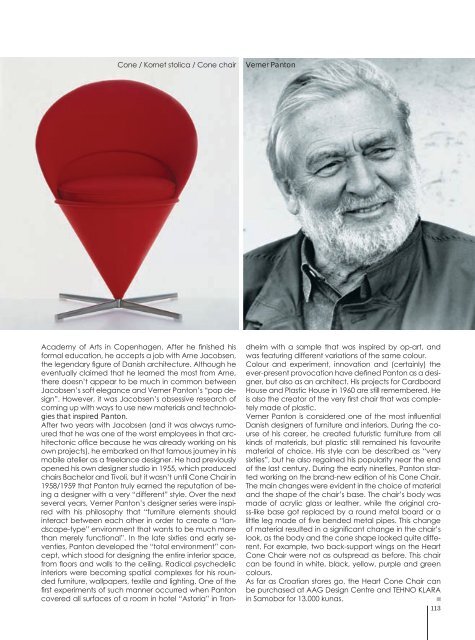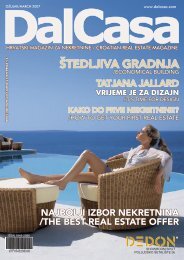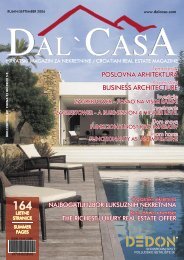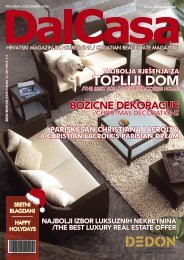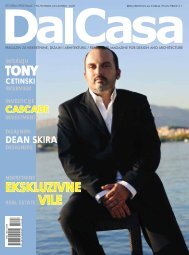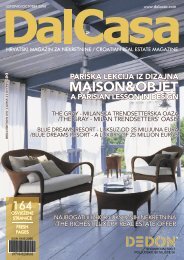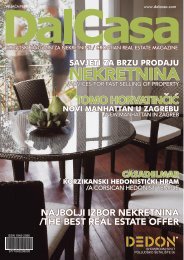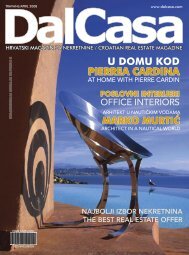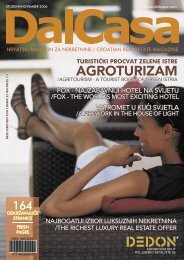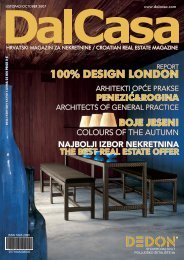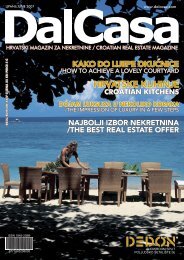at home with antonio fusco sve o grijanju - DalCasa
at home with antonio fusco sve o grijanju - DalCasa
at home with antonio fusco sve o grijanju - DalCasa
- No tags were found...
You also want an ePaper? Increase the reach of your titles
YUMPU automatically turns print PDFs into web optimized ePapers that Google loves.
Cone / Kornet stolica / Cone chairVerner PantonAcademy of Arts in Copenhagen. After he finished hisformal educ<strong>at</strong>ion, he accepts a job <strong>with</strong> Arne Jacobsen,the legendary figure of Danish architecture. Although heeventually claimed th<strong>at</strong> he learned the most from Arne,there doesn’t appear to be much in common betweenJacobsen’s soft elegance and Verner Panton’s “pop design”.However, it was Jacobsen’s obsessive research ofcoming up <strong>with</strong> ways to use new m<strong>at</strong>erials and technologiesth<strong>at</strong> inspired Panton.After two years <strong>with</strong> Jacobsen (and it was always rumouredth<strong>at</strong> he was one of the worst employees in th<strong>at</strong> architectonicoffice because he was already working on hisown projects), he embarked on th<strong>at</strong> famous journey in hismobile <strong>at</strong>elier as a freelance designer. He had previouslyopened his own designer studio in 1955, which producedchairs Bachelor and Tivoli, but it wasn’t until Cone Chair in1958/1959 th<strong>at</strong> Panton truly earned the reput<strong>at</strong>ion of beinga designer <strong>with</strong> a very “different” style. Over the nextseveral years, Verner Panton’s designer series were inspired<strong>with</strong> his philosophy th<strong>at</strong> “furniture elements shouldinteract between each other in order to cre<strong>at</strong>e a “landscape-type”environment th<strong>at</strong> wants to be much morethan merely functional”. In the l<strong>at</strong>e sixties and early seventies,Panton developed the “total environment” concept,which stood for designing the entire interior space,from floors and walls to the ceiling. Radical psychedelicinteriors were becoming sp<strong>at</strong>ial complexes for his roundedfurniture, wallpapers, textile and lighting. One of thefirst experiments of such manner occurred when Pantoncovered all surfaces of a room in hotel “Astoria” in Trondheim<strong>with</strong> a sample th<strong>at</strong> was inspired by op-art, andwas fe<strong>at</strong>uring different vari<strong>at</strong>ions of the same colour.Colour and experiment, innov<strong>at</strong>ion and (certainly) theever-present provoc<strong>at</strong>ion have defined Panton as a designer,but also as an architect. His projects for CardboardHouse and Plastic House in 1960 are still remembered. Heis also the cre<strong>at</strong>or of the very first chair th<strong>at</strong> was completelymade of plastic.Verner Panton is considered one of the most influentialDanish designers of furniture and interiors. During the courseof his career, he cre<strong>at</strong>ed futuristic furniture from allkinds of m<strong>at</strong>erials, but plastic still remained his favouritem<strong>at</strong>erial of choice. His style can be described as “verysixties”, but he also regained his popularity near the endof the last century. During the early nineties, Panton startedworking on the brand-new edition of his Cone Chair.The main changes were evident in the choice of m<strong>at</strong>erialand the shape of the chair’s base. The chair’s body wasmade of acrylic glass or le<strong>at</strong>her, while the original cross-likebase got replaced by a round metal board or alittle leg made of five bended metal pipes. This changeof m<strong>at</strong>erial resulted in a significant change in the chair’slook, as the body and the cone shape looked quite different.For example, two back-support wings on the HeartCone Chair were not as outspread as before. This chaircan be found in white, black, yellow, purple and greencolours.As far as Cro<strong>at</strong>ian stores go, the Heart Cone Chair canbe purchased <strong>at</strong> AAG Design Centre and TEHNO KLARAin Samobor for 13.000 kunas.113


